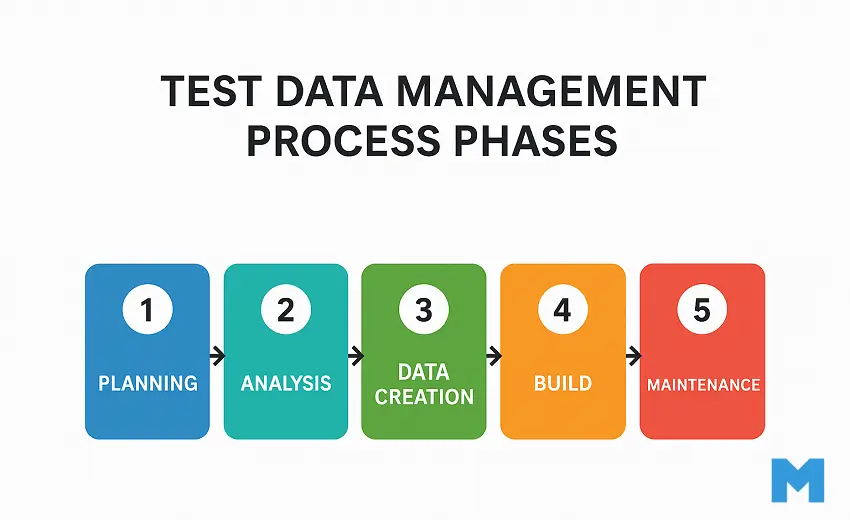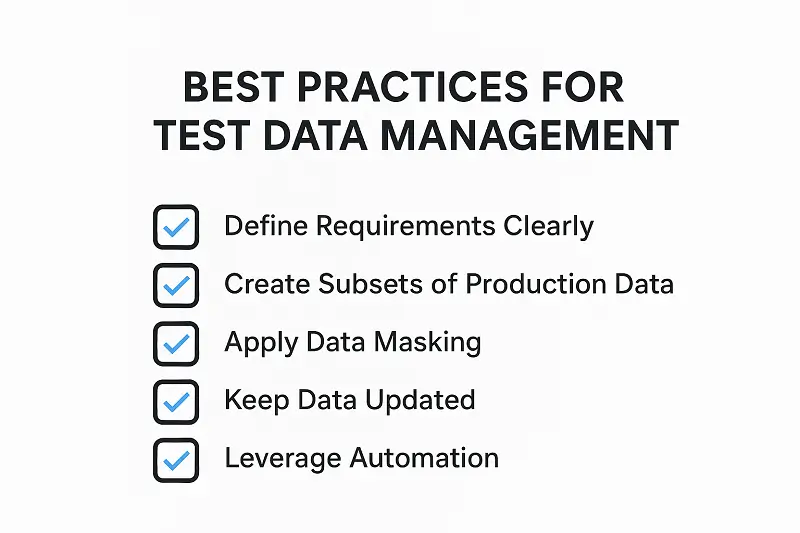
Test Data Management Guide 2025: Benefits, Phases and Strategies
You see new apps and digital products hitting the market almost every day. Businesses are in constant competition to be recognized as the best in the market. But what sets the winners apart? The answer is simple: flawless performance and that’s only possible through testing powered by effective Test Data Management.
Testing identifies glitches, performance gaps, and usability issues. However, to test effectively, teams need high-quality, reliable test data. This is where Test Data Management (TDM) comes into play. It ensures that accurate, secure, and production-like data is available for testing without exposing sensitive information.
So, what exactly is TDM, why is it essential, and how do businesses implement it effectively? Let’s explore.
What is Test Data Management?

Test Data Management (TDM) is the process of creating, managing, and organizing non-production datasets for software testing. These datasets mimic real-world scenarios while maintaining user privacy and data protection.
The goal of TDM is to provide realistic datasets that allow teams to test applications in conditions similar to live environments without risking exposure of personally identifiable information (PII).
Different organizations apply TDM in different ways depending on their testing needs. But the core objective remains the same supporting accurate, efficient, and secure software testing.
Why is Test Data Management Important in 2025?
Here are the key reasons why businesses prioritize TDM today:
1. Ensures Relevant and Accurate Data
Testing with outdated or incorrect data is like studying from the wrong textbooks, you’ll never pass the exam. Similarly, using irrelevant datasets in testing leads to inaccurate results. TDM ensures that test data is current, relevant, and aligned with testing objectives.
2. Compliance with Data Privacy Regulations
With strict privacy laws such as GDPR, HIPAA, and CCPA, mishandling sensitive data can lead to hefty fines. TDM uses data masking, synthetic data generation, and compliance monitoring to prevent accidental data leaks and keep businesses safe from lawsuits.
3. Reduces Data Complexity
Managing multiple, unorganized copies of data creates inefficiency. TDM minimizes clutter by providing streamlined, well-structured datasets, ensuring testers only work with what’s truly needed.
4. Faster Product Launches
Manual data collection can take days or weeks. TDM leverages automation and synthetic data generation to cut testing time dramatically. This accelerates development cycles and ensures products reach the market faster.
Test Data Management Process Phases
To implement TDM effectively, businesses follow five crucial phases:

- Planning – Identify test cases and define the data required (e.g., usernames for login tests).
- Analysis – Examine data type, format, volume, security measures, and access permissions.
- Data Creation – Decide whether to clone production data or generate synthetic datasets.
- Build – Implement chosen strategies, apply masking techniques, and set up secure environments.
- Maintenance – Update and manage test data regularly to ensure accuracy and compliance.
Best Practices for Test Data Management

Here are proven strategies for making TDM more effective:
- Define Requirements Clearly
Avoid creating unnecessary datasets. Focus only on the information needed for test cases. - Create Subsets of Production Data
Use smaller, relevant slices of data to reduce complexity while retaining critical details. - Apply Data Masking
Mask sensitive customer or client data before transferring it to test environments. - Keep Data Updated
Outdated test data produces unreliable results. Refresh datasets regularly to reflect real-world changes. -
Leverage Automation
Use automated tools to compare test results against baselines, saving time and reducing errors.
Top 5 Test Data Management Tools in 2025
Here are five leading tools businesses can use for effective TDM:
| Tool | Key Feature | Best For |
|---|---|---|
| GenRocket | 660+ data generator | On-demand synthetic data |
| K2View | Handles 5B+ queries daily | Enterprise-scale environments |
| Datprof | Centralized management | Multi-environment test data |
| Informatica | Automated data discovery | Salesforce users |
| InfoSphere Optim | Strong compliance focus | Privacy-driven industries |
Frequently Asked Questions (FAQs) on Test Data Management
The main purpose of TDM is to provide high-quality, secure, and realistic datasets for software testing. It ensures that applications are tested under conditions similar to real-world usage without exposing sensitive data.
TDM protects sensitive information through techniques like data masking, anonymization, and synthetic data generation. These methods prevent exposure of Personally Identifiable Information (PII), helping companies comply with regulations such as GDPR, HIPAA, and CCPA.
Synthetic test data is artificially generated information that mimics real-world data but doesn’t belong to actual users. It allows testing teams to simulate realistic scenarios without risking data breaches.
Yes. By automating test data creation and eliminating manual data collection, TDM speeds up testing cycles. This accelerates development timelines and helps businesses release products faster.
Industries that deal with large amounts of sensitive data such as banking, healthcare, insurance, retail, and telecom benefit the most from TDM. These industries require strong compliance, security, and reliable application performance.
Some common challenges include:
Managing large volumes of data efficiently
Ensuring compliance with evolving privacy regulations
Balancing cost and resource allocation
Keeping test data consistently updated
Some of the top TDM tools include GenRocket, K2View, Datprof, Informatica, and InfoSphere Optim. The best choice depends on business needs, testing environments, and compliance requirements.
Yes. While large enterprises benefit the most, small and mid-sized businesses can also adopt TDM using cost-effective tools or open-source solutions. This ensures reliable testing without overburdening resources.
Conclusion
Test Data Management is no longer optional, it’s a necessity for businesses aiming to release secure, high-performing, and reliable applications.
By ensuring data accuracy, protecting privacy, reducing complexity, and speeding up development, TDM directly impacts product quality and time-to-market.
To maximize success, organizations should follow the five phases of TDM, adopt best practices, and choose the right tools for their needs.
In 2025 and beyond, effective TDM will remain one of the most important strategies for delivering software that users can trust.